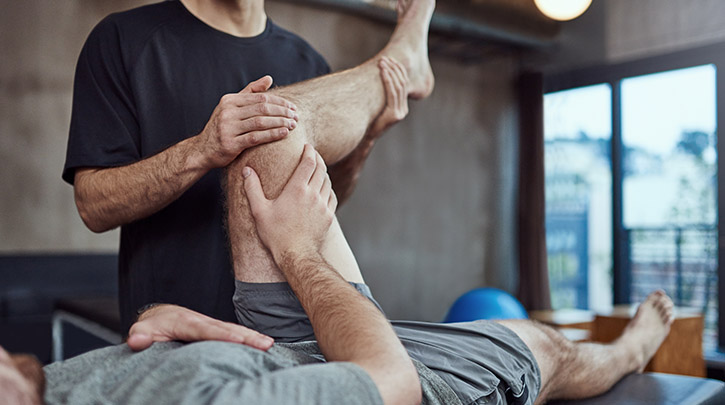
- United States
Get non-surgical solutions for today's top aesthetic concerns with Venus Treatments. Join thousands of satisfied patients worldwide!
- Loading...
- All Regions
Get non-surgical solutions for today's top aesthetic concerns with Venus Treatments. Join thousands of satisfied patients worldwide!

It’s no secret that desk jobs and occupations requiring repetitive tasks are leading to strain and pain. In fact, recent statistics place repetitive strain injuries (RSIs) as one of the most common and growing occupational-related injuries with one-third of all work absence cases involving a musculoskeletal injury, a classification that includes RSIs, according to reports from the Bureau of Labor Statistics (BLS). Increased responsibilities as a result of technological efficiencies, quicker paces, tighter deadlines, and more are all bound to increase that rate if we don’t change the ways in which we approach our work.
Because an RSI develops gradually over time, the symptoms often go unnoticed until it’s too late to avoid the injury altogether. If they are left untreated, RSIs can have a significant impact on one’s standard of life, particularly as a result of extreme and debilitating pain and reduced range of motion that can significantly affect day-to-day tasks and render the employee unable to complete their responsibilities while on the job. What measures can be taken to avoid a repetitive stress injury at work?
Anyone whose occupation requires them to remain seated or standing in the same or similar position for extended periods or perform the same task with limited motion is at a higher risk of developing an RSI. The best course for injury prevention in many cases is designing an ergonomic workstation that prioritizes proper posture. Ideally, a workstation should be designed to adapt to standing or sitting to allow you to mix it up and keep your body limber and pain-free.
For those who work at a desk for most of the day, consider the following notes to improve posture:
As for occupations that require a lot of standing, posture is still a priority. As much as possible, keep your head, shoulders, hips, and feet aligned. Use an anti-fatigue mat to reduce strain on the feet, knees, and back and take regular breaks to move and stretch. If using cleaning tools, opt for extension poles or handles that are long enough to prevent excessive hunching or bending over.
A simple stretch each hour or so while you’re working or performing repetitive tasks can go a long way in preventing RSIs, while fitting in a yoga class between shifts can benefit both muscle strengthening and weight loss. Easily fit these stretches into mini-breaks during work or use them as a tool to relieve tension outside of work hours.
Tips for preventing RSIs at work will understandably vary by occupation. The following is a sample of what you might be able to adapt, depending on what repetitive movements you may perform at work, to prevent an injury. Start by incorporating any tips you feel may relieve some strain and pain for you, based on the demands of your job.
If your company has a Human Resources (HR) Manager or designated health and safety representative, tap into their expertise on this topic for customized tips. Your HR manager will also be able to offer details on what additional treatments may be covered under your company’s health benefits plan for treating or preventing RSIs.
While ergonomic workstations, stretching, regular breaks, and changes in tasks can certainly help to prevent RSIs, everybody is different. What works for one may not work for you. If an RSI does set in, be sure to take appropriate measures to properly treat and heal your injury. There are many types of healing technologies for soft tissue injuries, some of which include splinting or compression bands, physiotherapy, massage therapy, and radio frequency-based soft tissue injury treatments that help to accelerate healing and improve range of motion as compared to physiotherapy alone. One of the most reliable radio frequency-based treatments is Venus Heal™.
With the Venus Heal™ device, three therapeutic modes of action—each proven in their own right to effectively target soft tissue injuries like RSIs—are combined into one powerful treatment. Whether used alone or as part of a holistic treatment plan, quick and comfortable Venus Heal™ treatments can help you return to the job faster without risking further soft tissue damage. To get all the details or to see if this treatment will work for you, simply use the search field below to locate a provider in your area.
Find a certified Venus Treatments provider near you today who specializes in today’s top aesthetic medical solutions.


Search below to find a provider near you and to learn about our non-surgical aesthetic treatments with ARTAS®, NeoGraft®, Venus Bliss™, Venus Bliss MAX™, Venus Versa™, Venus Legacy™, Venus Velocity™, Venus Viva™ MD, and Venus Glow™.
For more information call: (888) 907-0115 // [email protected] // 1880 N Commerce Parkway, Suite 2, Weston, FL, 33326 United States
REGULATORY CLEARANCES [ More ]
Venus Bliss™ is cleared by the FDA for non-invasive lipolysis of the abdomen and flanks in individuals with a Body Mass Index (BMI) of 30 or less, with the diode laser applicators. The (MP)2 applicator is cleared by the FDA for temporary reduction in the appearance of cellulite.
Venus Versa™ is cleared by the FDA as a multi-application device intended to be used in aesthetic and cosmetic procedures. The SR515 and SR580 applicators are cleared by the FDA for the treatment of benign pigmented epidermal and cutaneous lesions and treatment of benign cutaneous vascular lesions. The HR650/HR650XL and HR690/HR690XL applicators are cleared by the FDA, for the removal of unwanted hair and to effect stable long-term or permanent hair reduction for Fitzpatrick skin types I-IV. The AC Dual applicator is cleared by the FDA for the treatment of acne vulgaris. The DiamondPolar™ and OctiPolar™ applicators on the Venus Versa™ system are cleared by the FDA for non-invasive treatment of moderate to severe facial wrinkles and rhytides on females with Fitzpatrick skin types I-IV. The NanoFractional RF™ applicator is cleared by the FDA for dermatological procedures requiring ablation and resurfacing of the skin.
NeoGraft® is cleared by the FDA with indication for use in suction-assisted follicular extraction and re-implantation. NeoGraft® is an auto-graft system and can be used on both male and female patients.
ARTAS iX™ is cleared by the FDA with indication for use for harvesting hair follicles from the scalp in men diagnosed with androgenic alopecia (male pattern hair loss) who have black or brown straight hair. ARTAS iX™ is intended to assist physicians in identifying and extracting hair follicular units from the scalp during hair transplantation; creating recipient sites; and implanting harvested hair follicles.
Venus Legacy™ is cleared by the FDA for the non-invasive treatment of moderate to severe facial wrinkles and rhytides in females with Fitzpatrick Skin Types I-IV with the OctiPolar™ and DiamondPolar™ applicators, and temporary reduction in the appearance of cellulite with the 4D Body (LB2) and 4D Face (LF2) applicators.
Venus Velocity™ is cleared by the FDA for hair removal, permanent hair reduction (defined as the long-term stable reduction in the number of hairs re-growing when measured at 6, 9 and 12 months after the completion of a treatment regimen), and the treatment of pseudofolliculitis barbae for all Fitzpatrick skin types.
Venus Viva™ is cleared by the FDA for dermatological procedures requiring ablation and resurfacing of the skin. The DiamondPolar™ applicator is cleared by the FDA for the treatment of moderate to severe wrinkles and rhytides in Fitzpatrick skin types I-IV.
Venus Freeze Plus™ is cleared by the FDA for the non-invasive treatment of moderate to severe facial wrinkles and rhytides in Females with Fitzpatrick skin types I-IV.
Venus Heal™ is cleared by the FDA for the relief of minor muscle aches and pain, relief of muscle spasm, and temporary improvement of local blood circulation. These indications enable the treatment of certain soft tissue injuries and conditions.
Venus Freeze™ is cleared by the FDA for the non-invasive treatment of moderate to severe facial wrinkles and rhytides in Females with Fitzpatrick skin types I-IV.
Venus Glow™ is cleared by the FDA as a Class I motorized dermabrasion device. It provides a dermal rejuvenation treatment that works to open up and deep-clean pores. Venus Concept is the exclusive distributor for Venus Glow™.
Venus Swan™ is cleared by the FDA for the non-invasive treatment of moderate to severe facial wrinkles and rhytides.
Copyright © 2024 Venus Concept. All rights reserved.
You are entering our website. For other countries/regions and language options, please click the SELECT A DIFFERENT REGION button below.
SELECT A DIFFERENT REGIONAre you looking to get a treatment? Please visit our patient website to learn more.
Click HereUnsure which aesthetic treatment is right for you? Take this quick and easy quiz to discover treatments that suit your needs.
Get Started